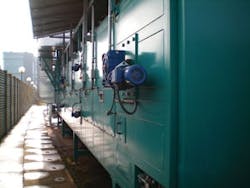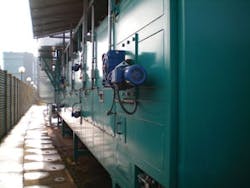Anti-Microbial Additive Helps Concrete Survive in Sewer Project
The Metropolitan St. Louis Sewer District (MSD) faced a problem familiar to many big city wastewater departments managing underground assets. A large (72-inch) sanitary sewer needed to be replaced with an even larger line to handle wet weather flows and eliminate sanitary sewer overflows (SSOs). In the years since initial installation, the above-ground area had become heavily developed.
"We're handling the Coldwater Creek project in three phases," said MSD Principal Engineer Greg Tolcou, P.E., "and this phase is the shortest. It is a 2,300-foot stretch that passes (at an average depth of 20-25 feet to flow line) under Lindbergh Boulevard. It also passes under a 20-inch gas line, a 24-inch water main, a condominium complex lake, the parking lot and the improvements for a driving range. The projected cost to restore surface disruptions is getting so high on these kinds of projects that tunneling is becoming more and more cost effective."
ConmicShield®, an anti-microbial additive, is mixed directly into the concrete and permanently inhibits Thiobacillus growth.
In fact, tunneling made so much sense on this phase of the project that the bid-winning contractor, SAK Construction LLC, decided to use 96-inch pipe, rather than the specified 90-inch, in order to use a tunnel boring machine (TBM). But choosing the right material for 2,300 feet of very large diameter pipe created its own set of challenges.
Concrete Specified
"PVC pipe might have been a good choice, but it's not available at that size," said Tolcou, "and fiberglass wouldn't work at this depth–the extra shoring and bedding required, along with its cost, made it too expensive for this project."
That left concrete. It could stand the stresses of being jacked in behind the TBM; it didn't need special shoring or bedding, and it is inherently inexpensive compared to other options. And besides, "St. Louis is a concrete town," Tolcou said. Because the city is on the Mississippi River and near sources of cement, limestone and sand, concrete pipe makers are easy to find in St. Louis.
That didn't mean concrete was an easy choice.
"There's a perception about concrete pipe in sanitary sewer applications," said Dan Swidrak, P.E., a product engineer at Independent Pipe, which cast the Coldwater Creek pipe, "people worry that the line may corrode."
Corrosion is a very real problem. Warm temperatures, turbulence, organic waste, and low oxygen levels common in sanitary sewers create hydrogen sulfide gas and breed Thiobacillus bacteria. In turn, the Thiobacillus colonize in the concrete pipe and begin converting hydrogen sulfide into sulfuric acid – some species of Thiobacillus have been shown to thrive in sulfuric acid solutions as concentrated as 7 percent, an equivalent pH of 0.5. The acid, of course, attacks the concrete matrix. In the right – or rather, wrong –conditions, microbiologically induced corrosion (MIC) can quickly destroy unprotected pipe.
Fighting MIC is tough. Chemicals like potassium permanganate, chloride, and oxygen can be injected into flows to combat hydrogen sulfide build up, but regular chemical addition is quite expensive. Concrete pipe can also be lined with vinyl but, "It's very labor intensive," Tolcou said, "each piece has to be welded at the joints by hand, and it's subject to nicks and pinholes, which allow gas penetration."Concrete was selected because of its ability to withstand the jacking forces and depth of bury for this project.
If linings are compromised, bacteria and gas can easily work together in the space between the lining and pipe, causing serious deterioration, which is hard to detect with TV inspection until there is a catastrophic failure.
Anti-Microbial Additive
MSD specified the use of ConmicShield®, an anti-microbial additive that is mixed directly into concrete and permanently inhibits Thiobacillus growth.
MSD Materials Engineer Ron Moore said that MSD first used the additive eight years ago with excellent results on the Maline Drop Shaft, near Chain of Rocks Bridge. MIC had corroded more than five inches of the walls in the lower third of the 50-foot-deep structure.
Moore, supervisor of the restoration, said that it was a successful project: "We used ConmicShield® to repair the drop shaft, with severe deterioration in the bottom third – it was completely eaten out by gases – and we've been monitoring it ever since. Eight years later, I'm happy to say there's no deterioration whatsoever."
Tolcou was encouraged, but still, casting 2,300 feet of 96-inch reinforced pipe is a large undertaking. He worked closely with Swidrak and Independent Pipe, and even visited the plant to personally witness dosing, mixing and pipe production. Independent Pipe took extra steps as well.
"Quality Assurance (QA) was definitely on our minds," Swidrak said, "we worked with ConShield Technologies and MSD to certify our approach, and we bought a new delivery system that interacted with our computerized mixing system – that gave us a lot more control over the process. ConmicShield® replaces an equal volume of mix water, but does not affect the strength, flow or set times we designed. When batching the product, our computer guarantees proper dosing."
Independent Pipe also made test cylinders from each day's production. These cylinders can be tested at independent labs to ensure all bacteria are killed, thus providing effective verification that the anti-microbial agent has been integrated properly. The fact that additive is mixed into the concrete, and isn't just a coating applied to the pipe's surface, is what makes it effective in long-term applications.
As a final QA measure, Tolcou asked that the inside crown of the pipe be painted with a proprietary green paint. This will help identify the treated pipe in future CCTV inspections, and will also provide a quick visual check of surface integrity.
Conclusion
After phase three is completed, Coldwater Creek will resume flows and Tolcou is cautiously optimistic that this concrete pipe "will stand the test of time."
Concrete treated with anti-microbial agents is proving useful in St. Louis for rehabilitation of large sanitary sewer installations. It's also restoring the reputation of concrete pipe for sewer applications.
"With ConmicShield® protection to be useful," Swidrak said, "concrete can once again become the preferred material for sewer lines. When you look at the life cycle analysis and the ease of installation, pipe treated with ConmicShield® is definitely a very cost effective solution." WW
More WaterWorld Current Issue Articles
More WaterWorld Archives Issue Articles

